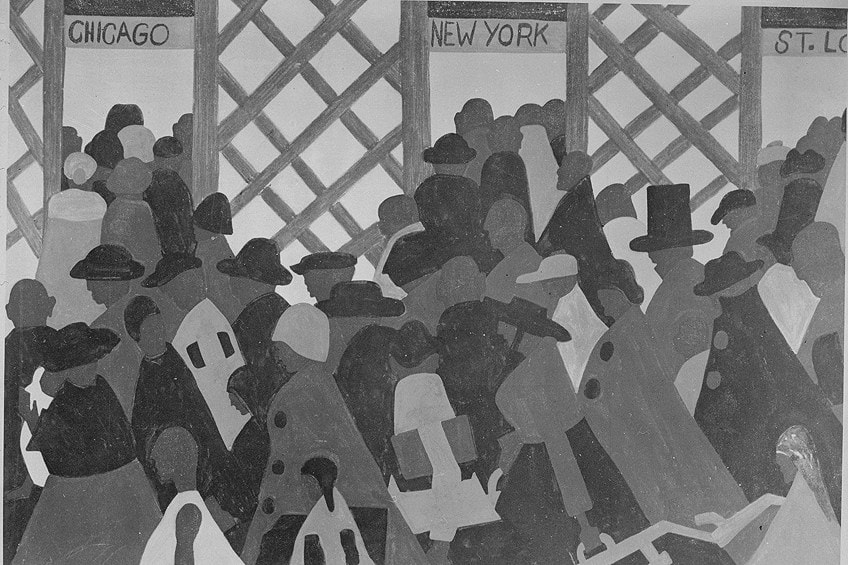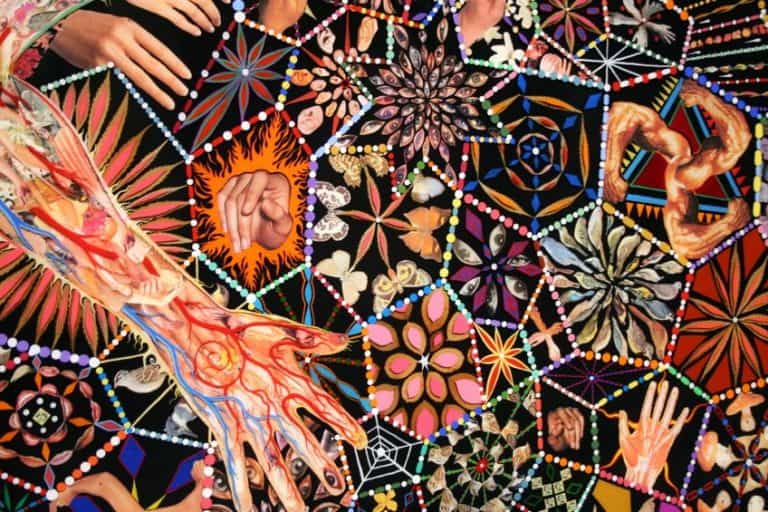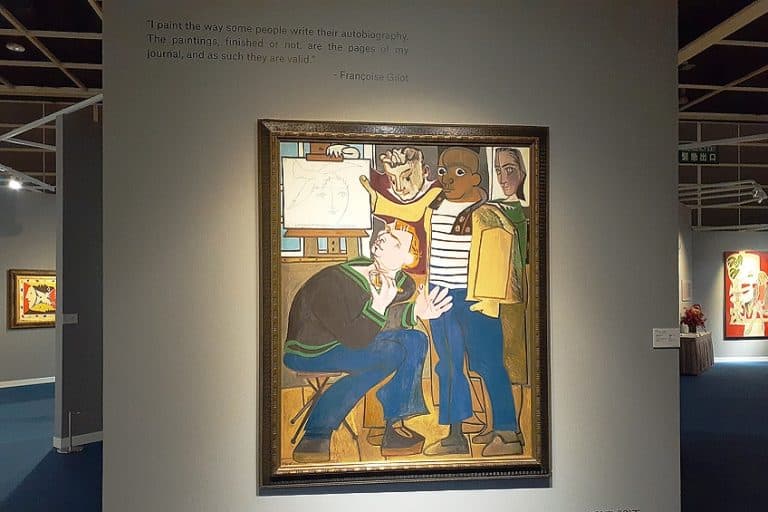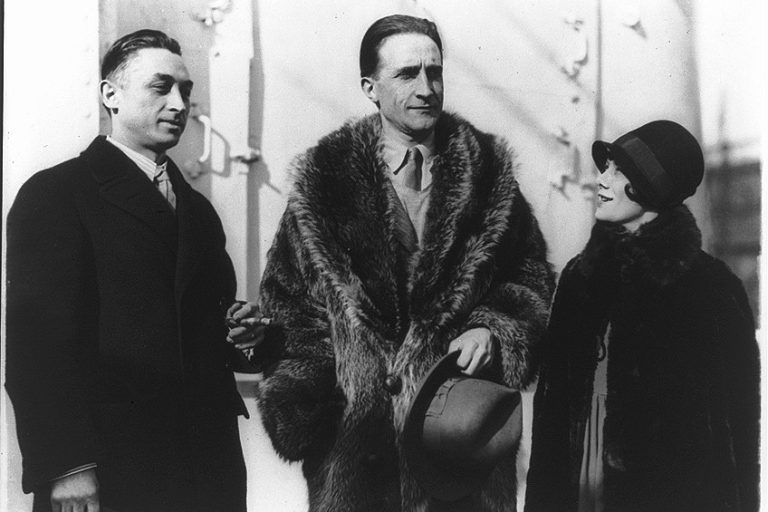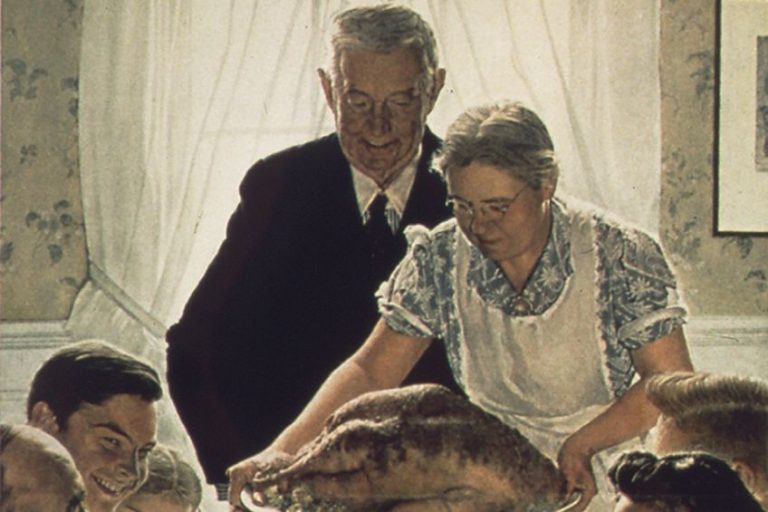Famous Black Painters and Artworks – Black Painters of Art History
For centuries, Black artists have made vast contributions to the world of art that have shaped visual culture, yet when we think of great artists throughout history the names that often come up are predominantly that of White artists. Throughout history, all over the world, famous Black painters and artworks have been disregarded and this has resulted in a popular history of art that has almost exclusively only acknowledged the talents of White artists. In this article, we will explore some of the famous Black artists that have made significant contributions to the world of art.
Table of Contents
- 1 Our List of Famous Black Artists You Should Know About
- 1.1 Joshua Johnson (c. 1763 – c. 1824)
- 1.2 Jacob Lawrence (1917 – 2000)
- 1.3 Chéri Samba (1956 – Present)
- 1.4 Jean-Michel Basquiat (1960 – 1988)
- 1.5 Iona Rozeal Brown (1966 – Present)
- 1.6 Chris Ofili (1968 – Present)
- 1.7 Kara Walker (1969 – Present)
- 1.8 Wangechi Mutu (1972 – Present)
- 1.9 Péju Alatise (1975 – Present)
- 1.10 Kehinde Wiley (1977 – Present)
- 2 Frequently Asked Questions
Our List of Famous Black Artists You Should Know About
Visual art created by Black artists is incredibly diverse. It often serves as a vessel of expression that depicts the social, political, and economic realities of these artists’ experiences; but also acts as a form of powerful cultural protest. Throughout history, the influence and impact of Black artists have regularly been disregarded and their talents, contributions, and achievements have not been recognized.
So, we will use this article to list some of the famous Black artists we think you should know about, who have made significant contributions to the world of art.
Joshua Johnson (c. 1763 – c. 1824)
| Artist | Joshua Johnson |
| Nationality | American |
| Birthplace | Baltimore, Maryland, United States |
| When Did They Live? | c. 1763 – c. 1824 |
| Associated Art Movements | Naïve Art |
Joshua Johnson lived and worked in Baltimore as a portrait painter during the 18th- and 19th-century. Although little is known of his background because of his status as a slave, he gained his freedom in 1782 and went on to become a portrait painter in 1796. Johnson is recognized as one of the most important Black history artists as he is the first documented African-American artist to work professionally.
He is celebrated for the contributions he made to famous Black artists as he forged a path for countless creatives that followed him.
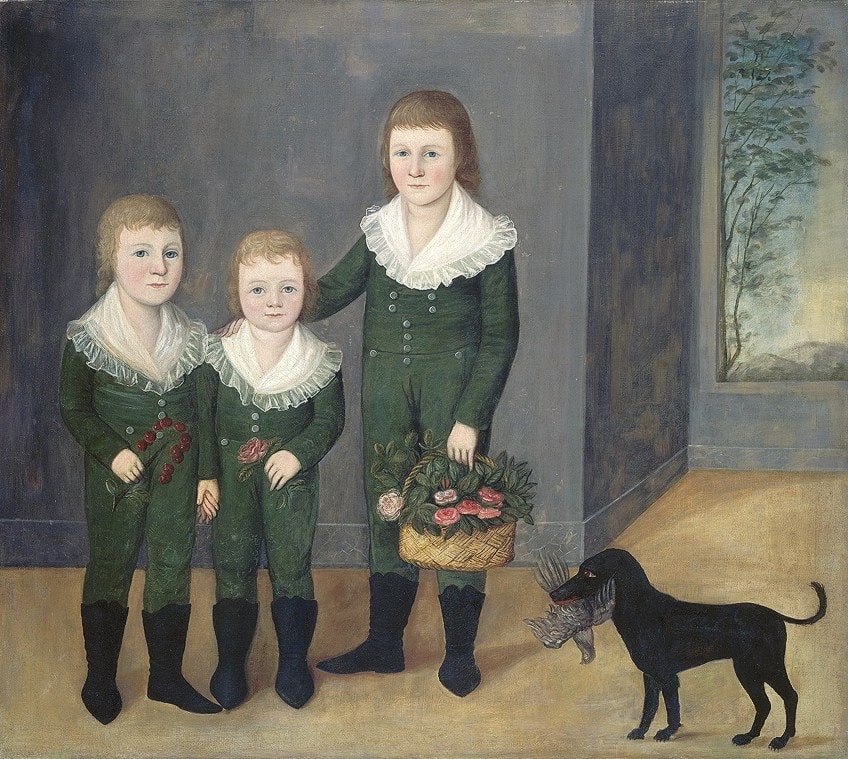
Johnson produced more than 100 portraits during his life. He referred to himself as a “self-taught genius” and his paintings were characteristically rendered in the Naïve art style. The majority of his Black history paintings shared a distinct composition and stiff manner where the subject would be seated and gazing straightforwardly in a three-quarter view in front of a plain backdrop, with a set of props that could include anything from parasols and riding crops to flowers and fruit. The subjects of his paintings were predominantly prominent White residents of Maryland.
Johnson paved the way for the famous Black painters and artworks that followed him because, despite his former status as a slave and the many insuperable barriers he had to overcome, he was the earliest African-American that was known to have crafted their own career as an artist. He worked profitably for more than 30 years and was able to pursue a career that was denied to African-Americans elsewhere.
Now, his Black history paintings sit in museums across the United States and act as a reminder of his achievements and his impact on other Black history artists.
A Few Famous Artworks by the Artist
- Grace Allison McCurdy and Her Daughters, Mary Jane and Letitia Grace (c. 1804)
- The Westwood Children (c. 1807)
- John Jacob Anderson and Sons, John and Edward (c. 1812)
Jacob Lawrence (1917 – 2000)
| Artist | Jacob Lawrence |
| Nationality | American |
| Birthplace | Atlantic City, New Jersey, United States |
| When Did They Live? | 1917 – 2000 |
| Associated Art Movements | Modernism |
When considering famous Black painters and artworks, Jacob Lawrence is one of the most esteemed Black American artists of the 20th century. Growing up, Lawrence had attended art workshops and museums, and in 1937 he joined the American Artists School on a scholarship. When he graduated, he had already developed his own take on modernism, where he illustrated African-American life using vivid color.
At 25 years old he became nationally known, which led him to establish himself as one of the most famous Black artists of his time.

Through the years he created commissioned pieces and contributed artworks to nonprofits such as the NAACP and the Children’s Defense Fund. He exhibited his most notable painting series, The Migration Series (1940 – 1941), at the Downtown Gallery, making him the first African-American to join Edith Halpert’s establishment. It depicted the mass exodus, where more than six million African-Americans fled the South, which was still segregated, for the urbanized areas on the other side of the United States.
Lawrence’s work was primarily inspired by the vivid colors and shapes of Harlem.
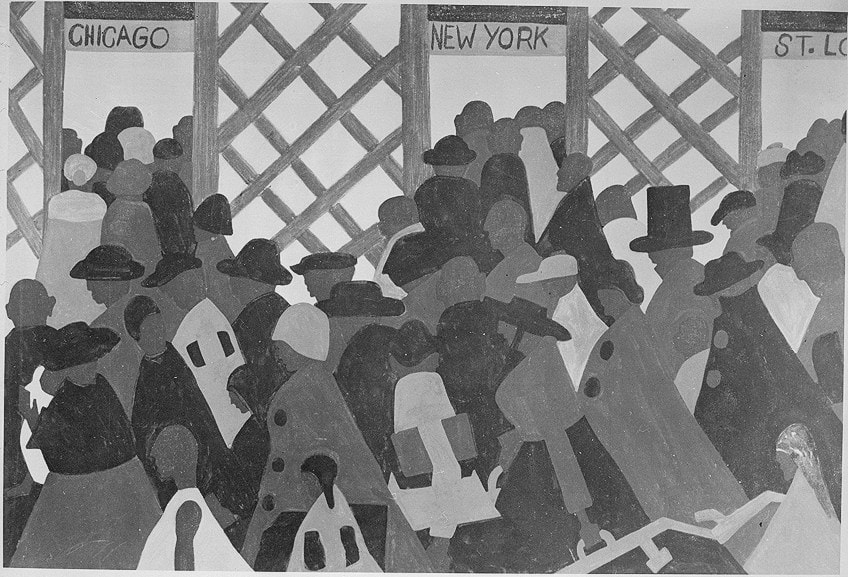
He referred to his style as “dynamic cubism”, which he used to bring the African-American experience to life, juxtaposing browns and blacks with bright colors. His contributions to the art world were widely recognized and he received critical acclaim, reaching several milestones such as becoming the first African-American to have his artwork become a permanent feature at the Museum of Modern Art (MoMA), and in 1990 he was the recipient of the U.S. National Medal of Arts.
Lawrence’s work directly reflected the time he was living in and was exceptionally influential. He shocked the contemporary audience with his modernist depictions of everyday life, as well as African-American historical figures and narratives. His 1947 The Builders painting has hung in the White House since 2009.
A Few Famous Artworks by the Artist
- General Toussaint L’Ouverture Series (1986)
- Migration Series (1940 – 1941)
- War Series (1946)
Chéri Samba (1956 – Present)
| Artist | Chéri Samba |
| Nationality | Congolese |
| Birthplace | Democratic Republic of Congo |
| When Did They Live? | 1956 to Present |
| Associated Art Movements | Contemporary African Art |
Chéri Samba is famed for his contemporary African artwork. His paintings share a glimpse of his perceptions of life in the Democratic Republic of Congo. Samba’s career began while working as a comic strip artist and billboard artist. He then moved on to painting, but as canvases were too expensive, he used sacking fabric as his base.
Soon, what was referred to as the “Samba signature” became a standard in his work, where he incorporated word bubbles to accommodate his written commentary, which provoked viewers to interact with his artwork.
Samba’s paintings explicitly tell you what he wants them to, there is no freedom of interpretation. Careful consideration is taken when he creates his compelling art pieces. Through his attempt to maintain authorial control Samba brilliantly commands the narrative of his work and protects himself by avoiding any imposed political interpretations and most importantly, he keeps the viewer from attaching their own perspective, which is often too normative and insufficiently decentered, to his work.
Samba’s artwork communicates his perception of the political, social, cultural, and economic realities of the Democratic Republic of Congo. He tackles subjects such as cultural customs, AIDS, social inequalities, corruption, sexuality, and what everyday life looks like in Kinshasa. Samba has explained that his goal is to appeal to people’s consciences and make people think.
As one of the significant Black pop artists in Africa, Samba creates a complex visual universe with his artwork.
The popularity of Samba’s paintings went beyond the borders of Kinshasa in the mid-1980s, where he gained an international audience. Samba has become one of the most famous Black pop artists who work with contemporary African art. His collections have been exhibited in galleries such as the MoMA and Paris’ Centre Georges Pompidou.
A Few Famous Artworks by the Artist
- J’aime la couleur (2003)
- Les Ombres Multicolores (2011)
- Problème d’eau. Où trouver l’eau (2004)
Jean-Michel Basquiat (1960 – 1988)
| Artist | Jean-Michel Basquiat |
| Nationality | American |
| Birthplace | New York City, United States |
| When Did They Live? | 1960 – 1988 |
| Associated Art Movements | Neo-Expressionism |
Jean-Michel Basquiat started by tagging subway trains in New York in the 1970s under his graffiti name “SAMO”. He worked with a close friend, leaving cryptic aphorisms on trains and buildings around Manhattan. He was a self-taught artist who began painting on sheets of paper his father, an accountant, brought home. With the encouragement of his mother, he went on to further his artistic pursuits. He quit high school with a year left and started selling postcards and sweatshirts that featured his work to make ends meet while living in his native New York.
Basquiat was popularly known for his distinct Neo-Expressionist style. His signature crown motif was featured in his earlier artwork to symbolize the celebration of Black people as royalty.
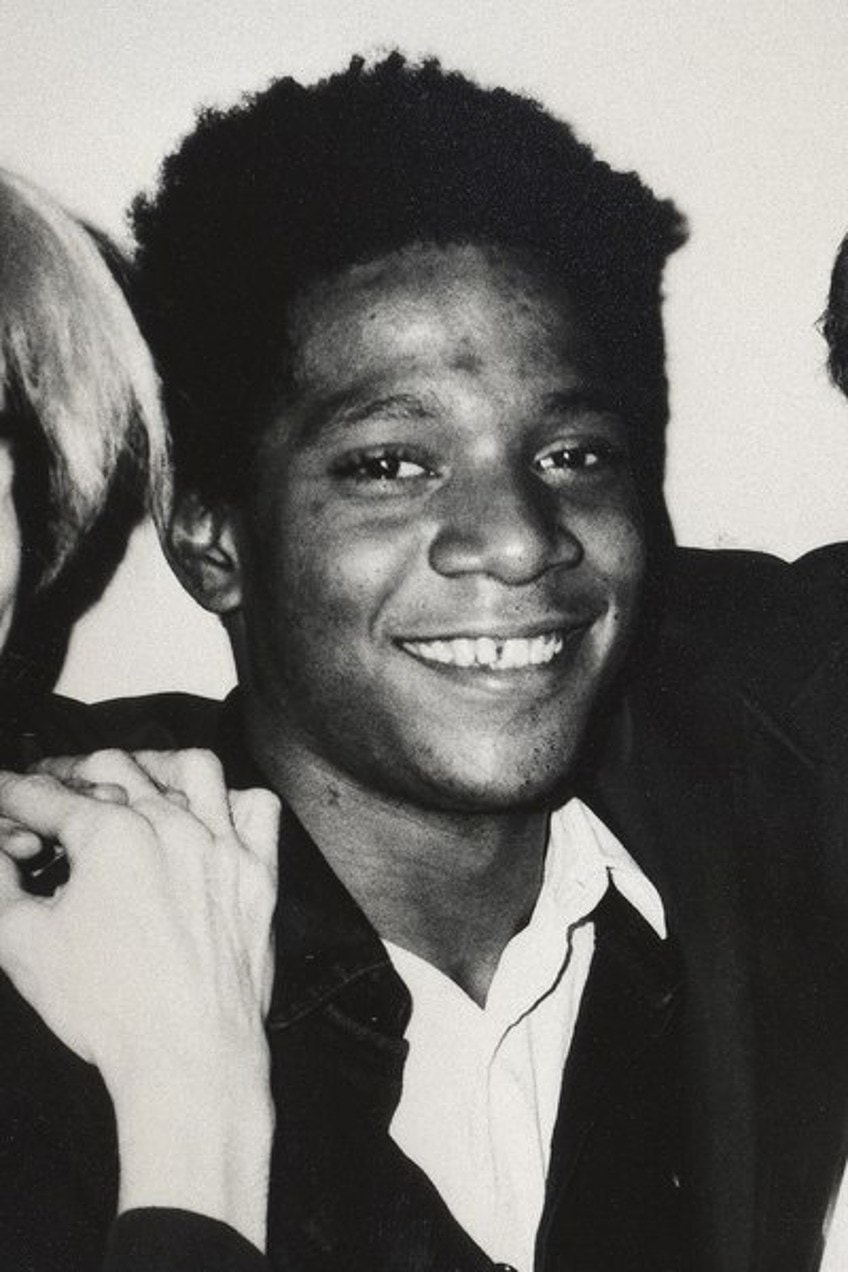
After three years of struggling, his genius was finally recognized. In 1980 his artwork was exhibited in a group show where he received critical acclaim. The art-loving public adored and admired his fusion of symbols, animals, stick figures, and words; with his artwork selling for as much as $50,000 for an original.
The formation of a new art movement coincided with his rise to fame and in the mid-1980s he collaborated with Andy Warhol, producing artwork that featured a series of cartoon characters and corporate logos.
Basquiat exhibited his artwork throughout the United States and the rest of the world, from the Ivory Coast, Abidjan, in Africa to Hanover, Germany. In 1986 Basquiat became the youngest artist to showcase their work at Germany’s Kestner Gesellschaft Gallery at just 25 years old.
Unfortunately, alongside his huge acclaim, Basquiat was battling addiction, he died from an overdose in 1988 at 27 years old. Although his artistic career was short-lived, he had an everlasting impact on the art world, credited for shedding light on the African-American and Latino experience and establishing a place for this experience in the elite art space. His 1982 “Untitled” painting of a skull was sold in 2017 at an auction held by Sotheby’s for a record-breaking $110.5 million to a Japanese billionaire.
A Few Famous Artworks by the Artist
- Irony of a Negro Policeman (1981)
- Untitled (1982)
- Hollywood Africans (1983)
Iona Rozeal Brown (1966 – Present)
| Artist | Iona Rozeal Brown |
| Nationality | American |
| Birthplace | Washington D.C., United States |
| When Did They Live? | 1966 to Present |
| Associated Art Movements | Contemporary Art |
When exploring famous Black painters and artworks, Iona Rozeal Brown is a contemporary artist to take note of. Brown’s narrative canvases demonstrate her comments on cultural identity. She takes a lot of inspiration from contemporary hip-hop and the Japanese ukiyo-e genre of printmaking. Brown only began painting in her twenties, as she first received her formal education, a BFA from the San Francisco Art Institute, and her MFA from Yale University.
She has taken part in various solo exhibitions across the United States between 2004 and 2014.
Brown was fascinated by the figure of the geisha, and she has thoroughly explored the subject in her artwork. She skillfully combines seemingly incompatible cultures. In her famous Black artwork, she uses stylized and fantastical mixed media to create her paintings, where she combines the various styles of graffiti, hip-hop, and Japanese prints.
When she studied in San Francisco she was exposed to the Japanese Ganguro culture, which appropriates Black culture. This prompted her to visit Japan to learn about this subculture. The trip inspired her celebrated series, The Blackface Paintings (2003), which jump-started her career. Brown’s concern with the appropriation of the African-American culture and with consumerism’s impact on the global construction of cultural identity is explored through her work.
Brown plays around with forms, colors, and texture in the flat, patterned artworks she creates with collage on paper, which indicates the cultural overlay of her work.
Her provocative work questions the power of image and the temptation of surface over substance when it comes to cultural forms. Her work appeals to viewers to take a few things into consideration, namely apprehension, authenticity, ownership, and identity when understanding globalization’s impact.
A Few Famous Artworks by the Artist
- a3 blackface #62 (2003)
- Browndemics: Lessons from Us (2007)
- died, T. (2011)
Chris Ofili (1968 – Present)
| Artist | Chris Ofili |
| Nationality | British |
| Birthplace | Manchester, England |
| When Did They Live? | 1968 to Present |
| Associated Art Movements | Punk Art |
Of all the famous Black painters and artworks, Chris Ofili stands out for his innovative approach to painting, that is– using elephant dung as one of his mediums. Ofili’s inspired artworks have garnered a lot of attention and praise. In 1998 Ofili received the British Turner Prize. Ofili’s art has been described as “punk art”, which uses various mediums including beads, resin, oil paint, glitter, porn magazine cut-outs, and elephant dung.
Ofili has noted the impact that the aforementioned Jean-Michel Basquiat has had on his work.
Ofili received his formal education from various institutions, including the Tameside College in Manchester, the Chelsea School of Art, and lastly the Royal College of Art in London. At 23 he was awarded a scholarship that let him travel to Zimbabwe, where he spent time studying cave paintings. This trip had a huge impact on his style, it is also where he first became fascinated with elephant dung. By incorporating it in some of his paintings or using it as the base on which his paintings stood, he encouraged the viewers to question the value they attached to things.
Ofili was particularly inspired by jazz and hip hop, which he saw as celebrations of Black culture. He painted what the music made him feel. In some of his paintings, he used cut-out images of Black musicians as a means to celebrate their talents and to acknowledge that his art was linked to theirs. His work highlights the distinctiveness of Black identities.
Although much of his artwork is a celebration of Black culture and the Black experience, he has also used his art to commemorate the trauma behind the Black experience, tackling issues such as racism.
It was groundbreaking when Ofili was selected as a member of the group, Young British Artists, as there were not many artists of African and Caribbean descent. Ofili is a force in the art world, in 2017 he was anointed Commander of the Most Excellent Order of the British Empire (CBE) by the Queen, for his services and contribution to art. In 2019 he appeared in Powerlist’s 100 Most Influential People of African or African Caribbean Heritage in the United Kingdom.
A Few Famous Artworks by the Artist
- No Woman No Cry (1998)
- The Adoration of Captain Shit and the Legend of the Black Stars (1998)
- The Upper Room (2002)
Kara Walker (1969 – Present)
| Artist | Kara Walker |
| Nationality | American |
| Birthplace | Stockton, California, United States |
| When Did They Live? | 1969 to Present |
| Associated Art Movements | Contemporary Art |
Kara Walker is one of the celebrated Black American artists whose work explores gender, race, sexuality, identity, and violence. Walker is a contemporary painter, print-maker, silhouettist, filmmaker, and professor. In 1994 her work became an instant success when she entered it into a talent show for the Drawing Center in New York. In 1997 Walker was awarded a MacArthur Fellowship and received the “genius grant”.
From that point onwards she has produced a number of artworks, with her work exhibited in museums and galleries across the world.
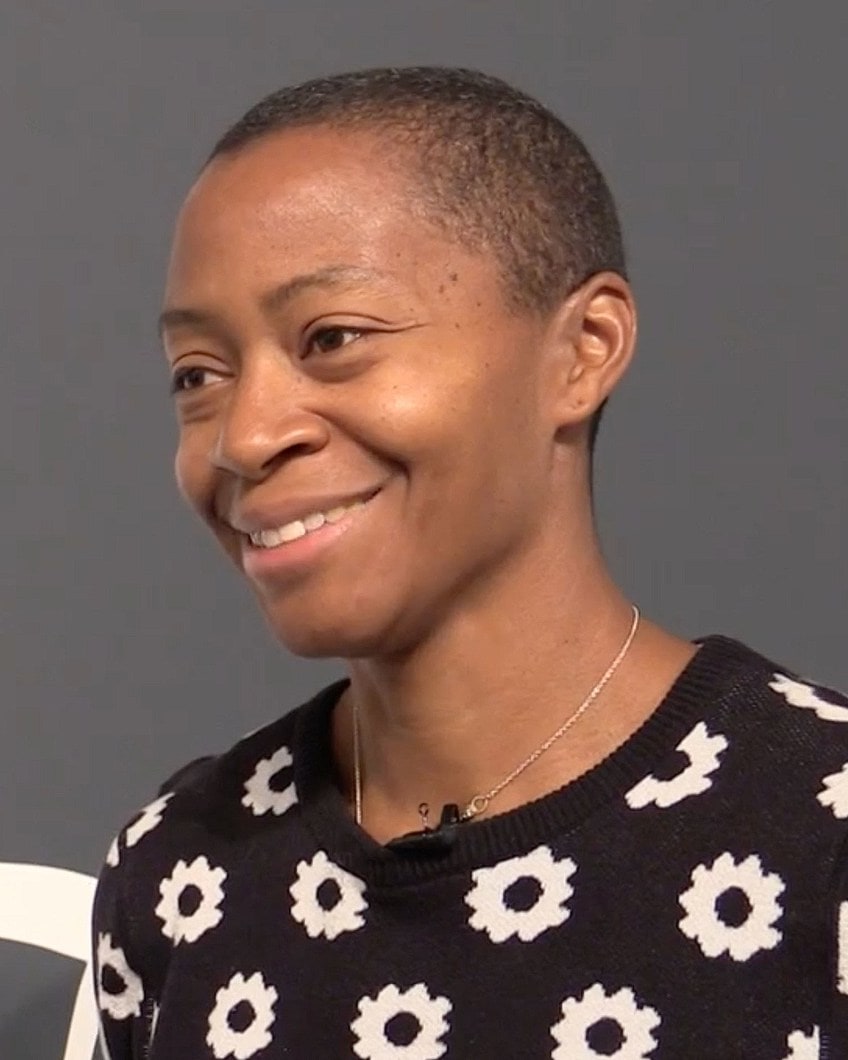
Walker knew from the age of three that she wanted to be an artist. She has experimented with different avant-garde styles through the years but her artistic intentions with her pieces have remained the same throughout. Walker sets out to create art that makes a statement or tells a story; her concerns are more about the message behind the art rather than the pursuit of perfection or beauty.
With the launch of Walker’s career, she became one of the predominant artistic voices that addressed the topic of race and racism.
Walker’s artistic feat has earned her many accolades. TIME magazine named Walker on its esteemed “TIME 100” list because of her masterful works and her ability to immerse her audience in grand designs without sparing the finer details. Walker takes on stereotypes and turns them on their head, picking them apart, nothing is off-limits to her as she revels in laughter and cruelty. She is unmoved by platitudes. Her bravery is showcased as she seemingly throws her silhouettes against the wall.

Although Walker’s work has been celebrated for her innovative approach to detailing history in her paintings, she has received major criticisms regarding her work. Other African-American artists have even attempted to boycott her work. That being said, her work is certainly complex and provokes strong reactions as she illustrates historical narratives that are haunted by subjugations, sexuality, and violence.
Her work exposes the psychological injury brought on by the legacy of slavery and critically examines contemporary gender and racial stereotypes.
A Few Famous Artworks by the Artist
- Gone: An Historical Romance of a Civil War as It Occurred Between the Dusky Thighs of One Young Negress and Her Heart (1994)
- No Place (Like Home) (1997)
- Darkytown Rebellion (2001)
Wangechi Mutu (1972 – Present)
| Artist | Wangechi Mutu |
| Nationality | Kenyan |
| Birthplace | Nairobi, Kenya |
| When Did They Live? | 1972 to Present |
| Associated Art Movements | Contemporary African Art, Afrofuturism |
The Kenyan artist Wangechi Mutu continues to produce art that is simultaneously captivating and shocking. Mutu’s work belongs to the Contemporary and Afrofuturism movement as she melds references from African culture with components of science fiction to construct characters that are both intriguing and disturbing. Her work conflates race, gender, personal identity, and art history.
She masterfully creates complex collages, sculptures, performances, and videos. Mutu’s artworks feature recurring motifs such as snake-like tendrils and masked women.
Mutu’s artwork reflects a pastiche-like combination of various textures and source material to delve into consumerism and excess. Her work is acknowledged for coming up with a divergent course of history for African people. She critically explores the impact of Western commercialism and American influence on contemporary African culture, whether it be insidious, innocuous, or invisible, it is definitely present. Her work centers on the misrepresentation Black women face in contemporary society.
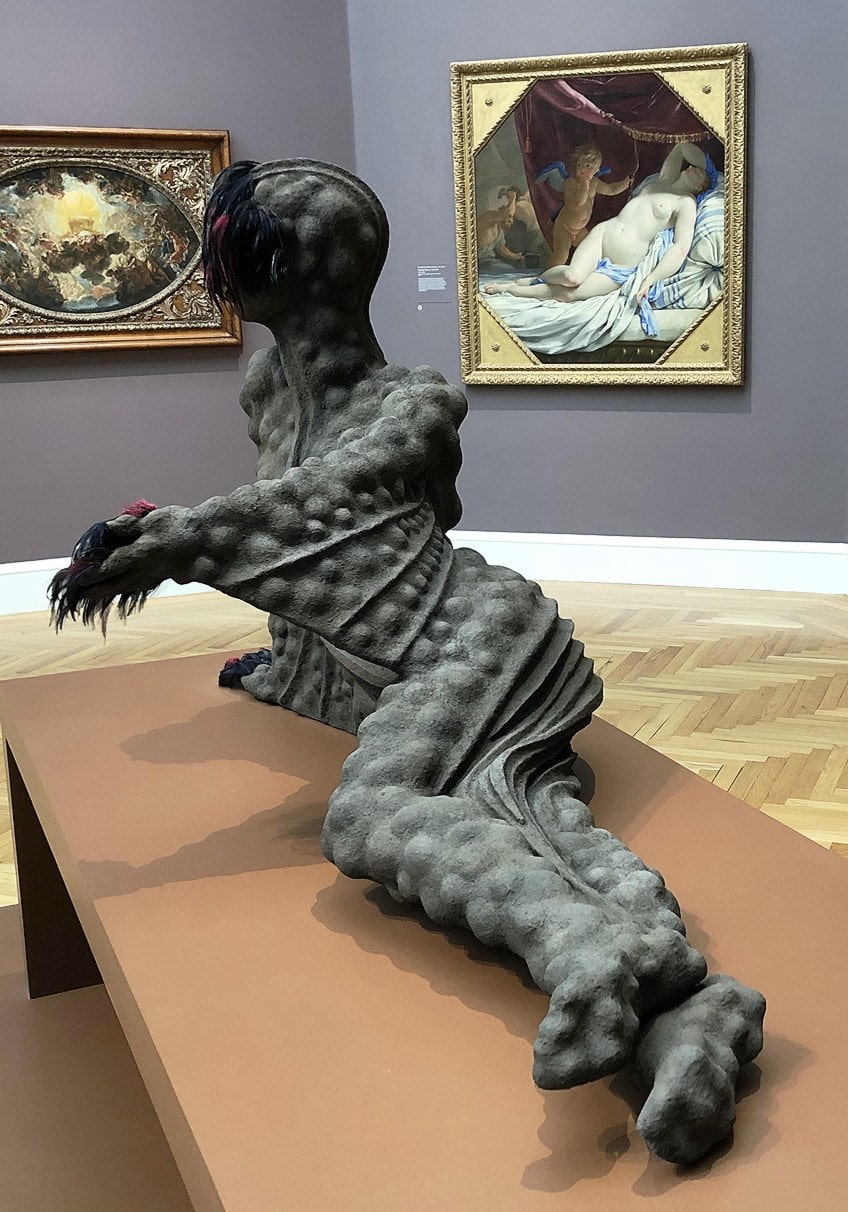
Mutu depicts various illustrations of femininity under the realm of Afrofuturism. The otherworldly figures of women she portrays engage the viewer and prompt discussions regarding the objectification of women; specifically, the hyper-objectification of Black women.
Mutu’s expression of women as otherworldly figures reiterates society’s fictitious portrayal of Black women.
Mutu has established a career that spans over 20 years, and she now resides in New York City. Her work has been exhibited all over the world including the Tate Museum in London, Miami Art Museum, Museum Kunstpalast in Düsseldorf Germany, San Francisco Museum of Modern Art, and the Centre Georges Pompidou, to name a few. To top it off, Mutu founded Africa’s Out! in 2014, a charitable organization that aims to support artists, institutions, and initiatives from Africa and its Diaspora and promote radical change using art and activism.
A Few Famous Artworks by the Artist
- Cancer of the Uterus (2005)
- Cactus Green Nips (2009)
- Homeward Bound (2010)
Péju Alatise (1975 – Present)
| Artist | Péju Alatise |
| Nationality | Nigerian |
| Birthplace | Lagos, Nigeria |
| When Did They Live? | 1975 to Present |
| Associated Art Movements | Contemporary African Art |
Péju Alatise is a multidisciplinary artist who crafts sociopolitical art that highlights the unique issues and struggles women in Nigeria, and the rest of Africa, are faced with. She originally received an education in architecture, but she pivoted, focusing on the visual arts where she took inspiration from ancient Yoruba mythology and the works of David H. Dale, a fellow Nigerian Artist. Her work is complex, experimental, and labor-intensive. Alatise is a leading voice for Contemporary art in Africa.
Alatise’s art has expanded to more extensive themes regarding widespread consciousness and change.
Her work and artistic practice are defined by her search for truth as she tackles the religious and political issues women face that are at the heart of Nigeria. Alatise attempts to visualize her country’s social issues and her personal experience. Considering Nigeria’s social views regarding gender, much of her work tackles women’s rights and gender inequality.
Her work strives to fracture the male mold of Contemporary African culture.
Alatise’s artwork has been exhibited in Florence, New York, London, and Morocco. She has received several awards and accolades for her famous Black artwork, including Johannesburg’s FNB Art Prize and from the Smithsonian National Museum of African Art. Alatise founded the nonprofit Alter Native Artists Initiative (ANAI), which acts as an artist collective, and incubator committed to the growth of visual arts in Nigeria. Alatise has used her artwork for the purpose of creative activism.
A Few Famous Artworks by the Artist
- Oritameta (Crossroads) (2008)
- See Me (I) (2015)
- Flying Girls (2017)
Kehinde Wiley (1977 – Present)
| Artist | Kehinde Wiley |
| Nationality | Nigerian American |
| Birthplace | Los Angeles, California, United States |
| When Did They Live? | 1977 to Present |
| Associated Art Movements | Contemporary Art |
In terms of famous Black painters and artworks today, Kehinde Wiley is making waves with his innovative take on portraiture. Wiley creates vibrant, political, and sensitive portrayals of African-American figures, that range from young teens he might meet on the street, to his fellow contemporary creators, not to mention the former U.S. President Barack Obama.
Wiley has reimagined traditional portraiture by incorporating modern culture with references to art history, such as the melding of French Rococo with today’s contemporary vision.

Wiley has gained respect for his naturalistic and vivid portraits of young African-American men, which usually have quite dramatic backgrounds filled with flowers. He knowingly challenges Black masculinity, which is often characterized as being synonymous with violence and fear in America. With his vibrant and lavish portraits, he challenges you as the viewer and whatever preconceptions you may have of his subjects.
Wiley uses his art to bring young men and people of color into the art world as they are so underrepresented in its museums and galleries.
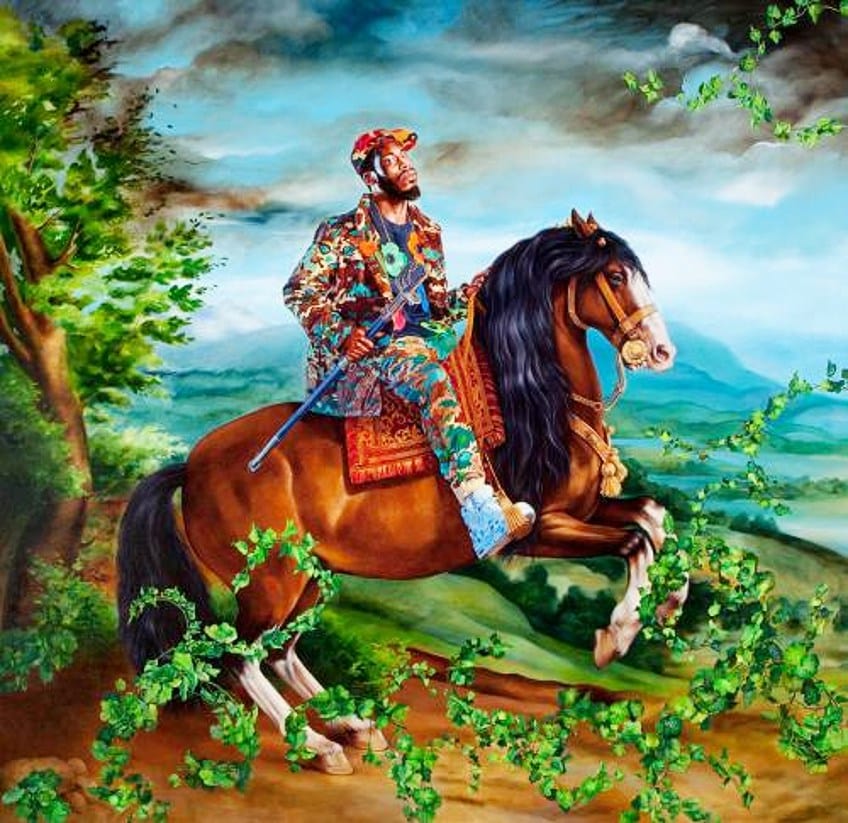
The theatricality of Wiley’s portraits is based on familiar images of prominent figures from the 17th- through to the 19th-century in Western art. Wiley lends the authority of these established figures to his 21st-century subjects. Wiley was recognized by TIME magazine as part of their 100 Most Influential People of 2018. The power of his portraits is in their heroic representation of African-American men which critically addresses how these men are often portrayed in contemporary culture.
A Few Famous Artworks by the Artist
- Easter Realness (2004)
- Ice T (2005)
- President Barack Obama (2018)
Our list only scratches the surface of some of the incredible Black artists that have lived throughout history and to this day, it is certainly not exhaustive! As you can see from our list, there is a diverse range of famous Black painters and artworks. There are far more Black artists that exist outside of our list; whether you are interested in Black history artists, or Black pop artists, or Black Contemporary artists, the list is endless, and they are all worth checking out! We encourage you to investigate further if you enjoyed this article and have a look at the rest of our website, where we delve into a diverse range of art topics!
Take a look at our black artists webstory here!
Frequently Asked Questions
What Is African-American Art History?
African-American art is an extensive term that essentially refers to visual art created by American artists who are Black. Art by Black artists ranges from Black pop artists to Black history artists and everything in-between. Black American artists and their artworks span across more than two centuries and the art they created is as varied and diverse as the artists themselves.
Who Was the First Documented African-American Artist?
Johnson is recognized as one of the most important Black history artists as he is the first documented African-American artist to work professionally. Johnson was one of the Black American artists who lived and worked in Baltimore as a portrait painter during the 18th- and 19th-century. Although little is known of his background because of his status as a slave, he gained his freedom in 1782 and went on to become a portrait painter in 1796. Johnson is one of many important Black history artists whose black history paintings and contributions to the art world forged a path for countless creatives that followed him.
Why Is It Important to Engage with Black Art?
Visual art by Black artists has been used to illustrate the Black experience. Famous black artwork often serves as a vessel that depicts the social, political, and economic realities these artists experience. Throughout history, the influence and impact of Black artists have regularly been disregarded and their talents, contributions, and achievements have not been recognized. This has resulted in a popular history of art that has almost exclusively only acknowledged the talents of White artists. It is important to engage with art by Black artists because it prompts the recognition of the diversity of art that is out there, and it highlights the talents of Black artists throughout history and to this day.
Isabella studied at the University of Cape Town in South Africa and graduated with a Bachelor of Arts majoring in English Literature & Language and Psychology. Throughout her undergraduate years, she took Art History as an additional subject and absolutely loved it. Building on from her art history knowledge that began in high school, art has always been a particular area of fascination for her. From learning about artworks previously unknown to her, or sharpening her existing understanding of specific works, the ability to continue learning within this interesting sphere excites her greatly.
Her focal points of interest in art history encompass profiling specific artists and art movements, as it is these areas where she is able to really dig deep into the rich narrative of the art world. Additionally, she particularly enjoys exploring the different artistic styles of the 20th century, as well as the important impact that female artists have had on the development of art history.
Learn more about Isabella Meyer and the Art in Context Team.
Cite this Article
Isabella, Meyer, “Famous Black Painters and Artworks – Black Painters of Art History.” Art in Context. December 2, 2021. URL: https://artincontext.org/famous-black-painters-and-artworks/
Meyer, I. (2021, 2 December). Famous Black Painters and Artworks – Black Painters of Art History. Art in Context. https://artincontext.org/famous-black-painters-and-artworks/
Meyer, Isabella. “Famous Black Painters and Artworks – Black Painters of Art History.” Art in Context, December 2, 2021. https://artincontext.org/famous-black-painters-and-artworks/.


